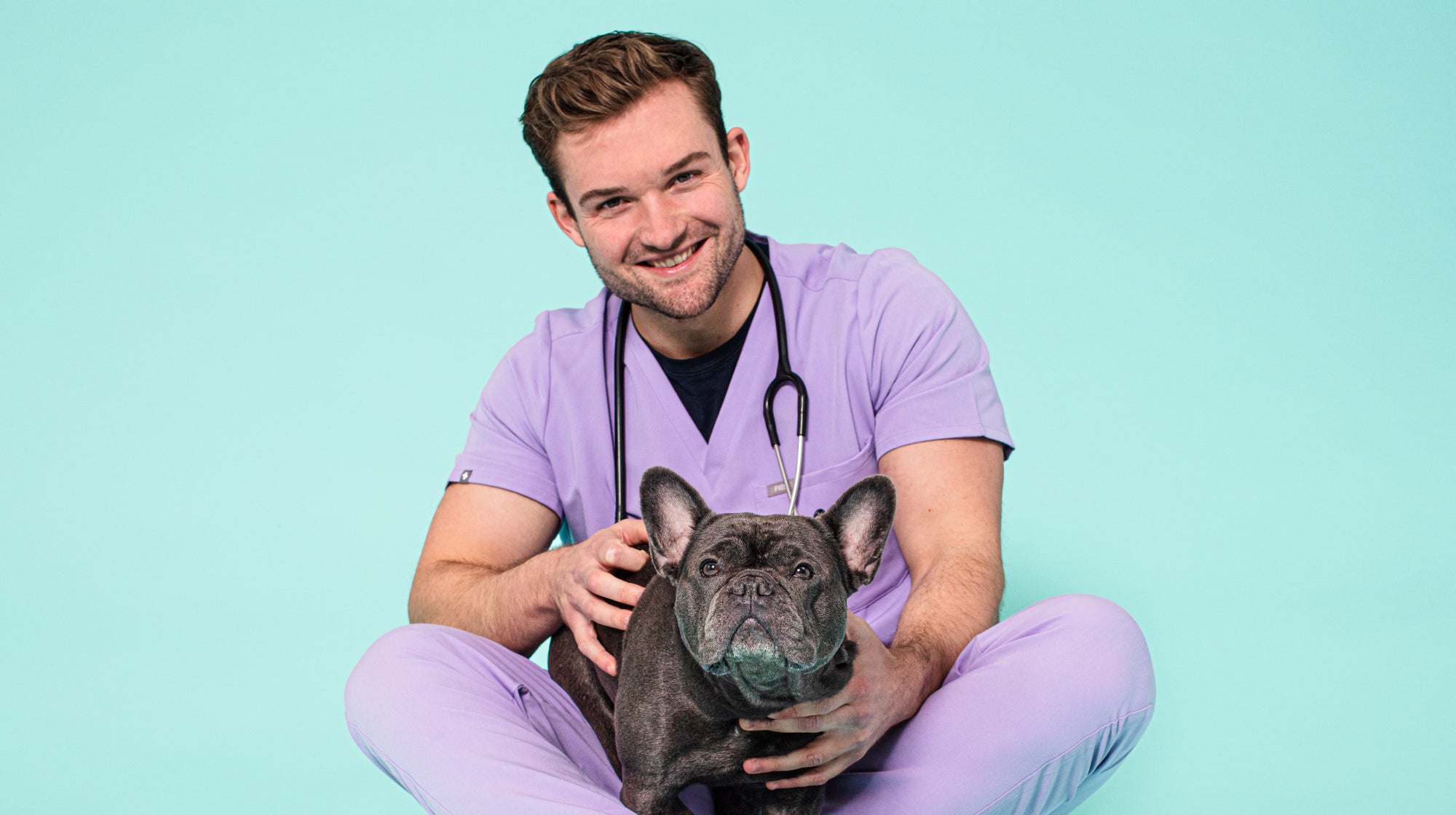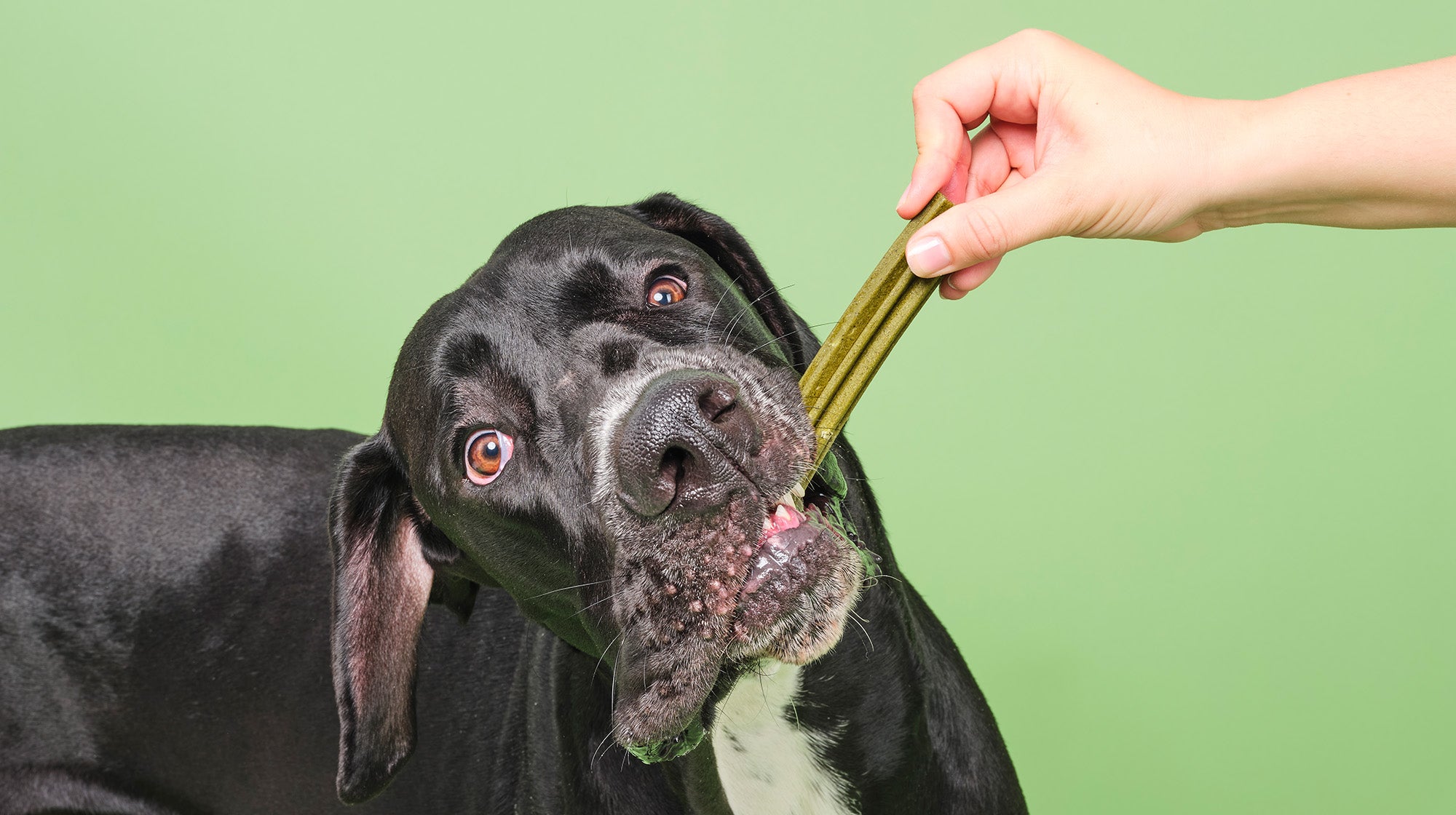FREE UK DELIVERY ON ORDERS OVER £39.99
As a vet, I've seen many dogs with bleeding gums over the years. It's a common issue that can worry pet owners and it’s important to be aware of the causes as bleeding gums in dogs can be caused by various factors, from mild plaque build-up to more serious health conditions.
Let's cover what could be causing your pup's gummy woes. We'll look at the common culprits, from plaque to more concerning conditions. By the end of this article, you'll have a better idea of what might be going on in your dog's mouth and what steps you can take to help.
Dogs can experience bleeding gums for various reasons. Let's explore the main reasons:
Periodontal disease, or more broadly referred to as dental disease, is the most common cause of bleeding gums in dogs. It starts with bacteria and plaque build-up on your dog's teeth. This sticky film hardens into tartar, irritating the gums and causes gingivitis. If left untreated, it can lead to more severe gum disease and eventually even bleeding of your dog’s gums.
Signs of periodontal disease include:
Regular teeth brushing, dental chews and dental check-ups can help prevent this issue. Your vet might recommend professional cleaning if the problem’s advanced.

Puppies often experience bleeding gums when they're teething. They have very sensitive teeth and like to explore the world through their mouth - this is normal and usually not a cause for concern. You might notice:
To help your teething pup, offer safe chew toys designed for puppies. Frozen carrots or ice cubes can also soothe sore gums. Remember, this phase is temporary and will pass as your puppy's adult teeth come in.
Sometimes, bleeding gums can be a sign of something more serious. Oral tumours or foreign objects stuck in your dog's mouth can cause bleeding and discomfort.
Signs to look out for:
If you spot any of these signs, it's crucial to take your dog to the vet straight away. Early detection can make a big difference in the outcome of treatment.
The least common cause of bleeding gums on this list, but nonetheless important to be aware of, are bleeding disorders. This is where your dog’s blood doesn’t clot properly and can be caused by a number of underlying conditions, such as infections or genetics.
Generally, this is very rare, so don’t jump to the conclusion that this is the cause of your dog’s bleeding gums. You may also notice bleeding or bruising in other areas of your dog’s body such as blood in the poop or urine - if this is the case then seek veterinary care straight away.

When your dog's gums bleed, it's often a sign of dental issues but there can be other causes too. Especially in the case of dental disease, you may see other symptoms too. Let’s cover some of these.
Is your dog's breath making you wrinkle your nose? Bad breath is a common sign of bleeding gums due to dental disease.
The odour comes from bacteria build-up. As plaque forms on your dog's teeth, it can lead to gum disease which causes inflammation and bleeding.
Don't ignore smelly breath! It's your cue to check your dog's mouth. Look for redness or swelling along the gumline. If you spot these signs, it's time for a vet visit. And remember, good dental care can prevent bad breath - brush your dog's teeth regularly and use dental chews or toys to help keep their mouth clean.
Have you noticed your furry friend turning up their nose at dinner? A reluctance to eat can be a sign associated with bleeding gums.
When gums hurt, chewing becomes painful. Your dog might:
These changes in eating habits shouldn't be ignored - they often mean your dog’s in pain, and soft, swollen, or bleeding gums can make every bite uncomfortable.
If you see these signs, check your dog's mouth carefully and look for red, puffy gums or visible blood. A vet check-up is crucial to address the underlying issue.
Is your dog leaving wet patches everywhere? Excessive drooling can also be a sign of dental disease, as well as bleeding gums.
Drooling increases when there's mouth pain or irritation. You might notice:
Excessive drooling often means your dog's mouth is uncomfortable, and could be due to gum inflammation or infection.
Check your dog's mouth for swollen, red gums or visible bleeding. If you spot these signs, book a vet appointment as early treatment can prevent more serious dental problems.

Regular check-ups with your vet are crucial for your dog's dental health. These visits can catch issues early and keep your furry friend's smile bright and healthy.
As a vet, I can't stress enough how vital early diagnosis is when you notice bleeding gums. When you bring your pup in for a check-up, we'll thoroughly examine their mouth, teeth, and gums.
During the visit, we might recommend x-rays to get a closer look at what's happening beneath the gumline. These images can reveal hidden problems that aren't visible to the naked eye.
If we spot anything concerning, we might suggest a biopsy or blood tests to rule out more serious conditions. Remember, catching issues early often means simpler, less costly treatments.
Don't wait for obvious signs of trouble. By the time you notice your dog's gums bleeding, the problem might be quite advanced. Regular check-ups can help prevent this and keep your pup's mouth healthy and pain-free.
Treatment of bleeding gums in dogs will depend very much on the underlying cause.
For bleeding gums due to dental disease, first up, proper dental cleaning is often the way to go. This involves a thorough scale and polish under anaesthesia to remove tartar and assess the extent of the problem.
For more serious cases, we might need to consider tooth extraction. It sounds scary, but removing any rotten teeth removes the source of the issue. Antibiotics may also be necessary for really nasty infections or tooth root abscesses.
For more serious conditions like oral tumours or bleeding disorders, more intensive treatments may be necessary such as surgically removing masses, chemotherapy, radiotherapy and other special medications.
Good oral hygiene for your dog is crucial to prevent gum bleeding and other dental issues. Let's explore some key ways to keep your furry friend's mouth healthy and happy:
Brushing your dog's teeth is the gold standard for dental care. Aim to brush daily, using a soft-bristled toothbrush and dog-friendly enzymatic toothpaste. Never use human toothpaste, as it can be harmful to dogs.
Start slowly, letting your pup get used to having their mouth touched and gradually introduce the toothbrush and paste. Be gentle and praise your dog throughout the process.
If brushing proves challenging, try dental wipes or finger brushes. These are easier to use and still help remove plaque.
Dental chews and toys can complement brushing as they help scrape off plaque through the mechanical action of chewing.
Diet plays a big role in your dog's dental health. Dry food can help scrape teeth clean as your dog chews. Avoid giving your dog table scraps or sugary treats as these can contribute to plaque build-up and tooth decay.
Fresh fruits and veggies like carrots and apples can serve as healthy, tooth-cleaning snacks.
Consider adding dental supplements to your dog's diet. These can help fight bacteria and freshen breath.
Book dental check-ups with your vet at least once a year. They'll examine your dog's mouth for signs of disease or decay.
Your vet might recommend professional cleaning under anaesthesia, which allows for a thorough clean above and below the gumline.
During check-ups, ask your vet to demonstrate a proper brushing technique. They can also recommend products tailored to your dog's needs.
Watch for signs of dental issues between visits - bad breath, reluctance to eat, or pawing at the mouth can indicate problems.
Remember, early detection is key. Regular check-ups can catch issues before they become serious, saving your dog discomfort and your money in the long term.

Keep your eyes peeled for the following red flags. If you notice any of them, then a vet visit might be needed:
Your dog's gum colour can tell you a lot about their overall health. It's a quick way to check if something might be wrong. Let's look at what normal gums should look like and what different colours might mean.
Healthy dog gums should be a nice pink colour which shows good blood flow and oxygen levels. When you press on healthy gums, they should briefly turn white and then quickly return to pink. This is called capillary refill time and indicates that the blood flow to your dog’s gums is normal and healthy.
You'll want to check your pup's gums regularly. Here's a quick checklist:
Colour: Pink (or black for some breeds)
Texture: Smooth and moist
Smell: No bad odour
Bleeding: None when touched

Sometimes, your dog's gums might look different. This can be a sign that something's not quite right.
As well as the above, here are the main colours to watch out for:
White or pale: This might mean anaemia or shock
Red: Could indicate inflammation or heatstroke
Blue or purple: Might show problems with oxygen flow to the gums
Yellow: Possible liver issues
Bleeding gums in dogs is a serious issue that shouldn't be ignored. It can signal various health problems, from minor irritations to severe conditions.
Regular dental check-ups are crucial. You should examine your dog's mouth weekly and brush their teeth daily if possible.
Plaque and tartar build-up are common culprits of bleeding gums in dogs. These nasties can lead to gingivitis and more severe gum disease if left unchecked.
If you spot bleeding gums, don't panic, but do take action! A visit to your vet is the best course of action. Remember, prevention is better than cure. A healthy diet, dental chews, and regular cleaning can work wonders for your pup's oral health.
Never miss a treat!
Subscribe to our newsletter and get blog articles amongst other treats delivered to your inbox

Comments (0)
Leave a comment